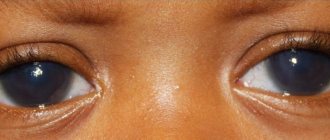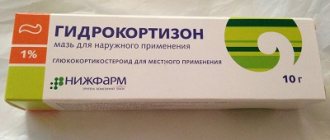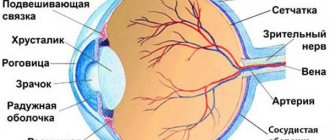Carrying a baby is an exciting and responsible period in a woman’s life, during which her body is most vulnerable to attacks by pathological microorganisms.
Even a slight disturbance in the usual state of health can seriously affect the general mood of the expectant mother. And even more so, the activation of pathogenic bacteria does not add to optimism. A disease such as stye chooses a woman’s eyelid as its “victim.” The pathology at first glance does not seem dangerous, however, under certain conditions it can negatively affect the health of not only the pregnant woman, but also the little one she carries in her womb. Timely seeking medical help contributes to effective, quick and, most importantly, safe victory over the disease.
Barley during pregnancy - what is it?
The term “barley” characterizes the presence of acute damage to the sebaceous gland of the eyelash or its hair follicle. Initially, a small, slightly painful “ball” forms at the site of infection. Subsequently, in the absence of treatment, the inflammatory process spreads and a cavity filled with purulent contents forms in the affected area. The disease causes a lot of inconvenience - the affected area hurts, the eye “twitches”, the formed abscess makes it difficult to look. Stye is not contagious. Depending on the location of the source of inflammation, the following are distinguished:
- External stye - located in the area of the hair follicle. A purulent tubercle protrudes from the outside of the eyelid.
- Internal stye is an inflamed “ball” located on the inner surface of the eyelid.
Pathology can affect both the upper and lower eyelids. Diagnosis of the disease in most cases is based on an assessment of the clinical picture. In acute cases of the disease, it is possible to extract purulent discharge to determine the causative agent of the disease.
Dangerous consequences
Is it possible to open a stye that has formed on the eyelid? To understand this, you need to understand what pathology is. Barley is a purulent abscess that forms in the area of the upper or lower eyelid and is accompanied by an inflammatory process. Its development is provoked by a bacterial infection (sometimes viral or fungal). The most common pathogen is Staphylococcus aureus. It provokes the development of an abscess due to the action of such internal factors:
- decreased immunity;
- hormonal imbalances in adolescents, pregnant or lactating women;
- various serious diseases (infectious, metabolic, gastrointestinal diseases);
- avitaminosis.
External factors also influence the development of the inflammatory process in the eye. For example, you can get an infection by not following the rules of personal hygiene, using other people's personal belongings or cosmetics.
Depending on the area of eye damage, there are 2 types of styes:
- External. Such an abscess is an inflammation in the eyelash follicles or in the sebaceous gland near them.
- Interior. This type of stye occurs on the inner edge of the eyelashes in the area of the meibomian glands.
To get rid of the unpleasant pathology, some try to squeeze out the stye. However, despite the seemingly harmless procedure, the consequences can be very serious. So what happens if you squeeze out an abscess on your eye? The main danger is the spread of infection and the development of complications as a result.
- Meningitis. This is an inflammatory process in the brain and spinal cord.
- Sepsis. This is a very dangerous condition when an infection from the eye enters the bloodstream, spreading through the bloodstream throughout the body.
- Phlegmon of the orbit. This pathology develops in the eye area and is accompanied by the spread of a purulent process throughout the entire orbit.
Such complications can become not only a threat to human health, but also to human life. Therefore, squeezing or piercing barley is strictly prohibited. It is better to wait until it matures and breaks through on its own.
What happens if you puncture or tear off a stye by accident? What actions should be taken? The best decision would be to urgently seek advice from an ophthalmologist. This is especially necessary if the following symptoms appear:
- high body temperature;
- severe headaches or dizziness;
- vision problems.
These signs often indicate the spread of infection in the body, including to the brain. Therefore, any delay in treatment of the onset of the inflammatory process leads to a deterioration in the patient’s well-being.
Even if the abscess greatly interferes with vision, under no circumstances should it be removed. Self-extruded stye can spread infection throughout the body, leading to the development of meningitis or sepsis.
It should be understood that this pathology, if it occurs naturally, does not pose a serious threat to the human body, but if the abscess is artificially opened, squeezed out or punctured, then complications will not be long in coming. The fact is that if an immature formation is touched, then the purulent discharge will not be able to flow out in full; it will easily penetrate inside the eye or into the circulatory system.
Among the most common complications that were observed in patients who squeezed out barley on their own, the following should be highlighted:
- phlegmon and abscess of the eyelid;
- thrombosis formed in the ophthalmic veins;
- brain inflammation;
- blood poisoning.
Stye on the eye during pregnancy
Unfortunately, expectant mothers are also susceptible to such a scourge as barley.
Causes of stye during pregnancy
The main reason for the appearance of almost any source of inflammation lies in the penetration of infection. However, most often the protective forces of the immune system attack enemy organisms in a timely manner and with sufficient force, and further spread of the infection can be stopped. What causes barley to appear in a pregnant woman?
- A common cause of inflammation of the sebaceous gland is infection with Staphylococcus aureus.
Pathogenic microorganisms most often enter the mucous membrane of the eyelid through dirty hands. Neglect of hygiene rules, especially when putting on or removing contact lenses, can lead to illness. In addition, the increased load on the entire body of a pregnant woman makes her immune system more vulnerable and weaker. As a result, the bacterium is able to multiply unhindered and actively.
- A hair mite, which can parasitize a visually healthy eyelid, also forms a focus of inflammation if conditions are favorable.
Vitamin deficiency also negatively affects the state of the expectant mother's body's defenses. This phenomenon is not uncommon, so pregnant women should be especially careful about their diet and take vitamins if necessary.
- The occurrence of infectious processes in the body of the expectant mother - damage to a viral infection, sore throat, pathology of the gastrointestinal tract.
In this case, the appearance of barley is not an independent disease, but one of the symptoms of a systemic infectious lesion.
- Presence of endocrine disorders (including diabetes mellitus).
- Iron deficiency (anemia).
Hypothermia and stress can also contribute to the development of the disease. The presence of the above factors will not necessarily lead to inflammation of the sebaceous gland, but they are predisposing circumstances.
Barley during pregnancy - manifestations of the disease
The increase in symptoms and deterioration of the clinical picture when barley occurs in expectant mothers occurs quite quickly.
Moreover, during the first day:
- Itching and redness of the eyelid occurs. A woman feels the urge to rub or scratch her eye.
- Next, a slight edema (swelling) forms and pain appears along the edge of the affected eyelid.
- A pregnant woman wants to blink more often.
- Bright light is annoying and your eyes get tired quickly.
- An increase in temperature may also occur, but not always.
But already on the second (less often third) day, the clinical manifestations of the disease intensify:
- A red, painful, well-defined bump forms.
- The pain intensifies.
- At the site of the tubercle, a pronounced abscess with a white or yellow head is formed.
The peak of the disease is the moment of release of pus through the ciliary follicles - 3-4 days after the formation of a purulent cavity. After this, the intensity of the inflammatory process decreases.
Causes of stye and symptoms
The most likely cause of stye is a bacterial infection. This inflammation is mainly caused by staphylococcal bacteria. Children and adults with weakened immune systems are at risk. Bacteria can get onto the mucous membrane in various ways:
- failure to comply with personal hygiene rules;
- close contacts with an already infected person;
- dust storms carrying debris;
- sudden changes in temperature outside;
- drafts;
- helminthic infestations;
- mechanical damage to the eye;
- contact of foreign fragments with the mucous membrane of the eye;
- diseases of the gastrointestinal tract;
- metabolic disorders;
- diseases of the endocrine system.
Staphylococcal infection is “wandering” in nature. It is activated in cases of decreased body resistance. Some people observe the following trend in the appearance of stye - it appears in the same area of the eyelid with a certain periodicity. There is reason to believe that a hair follicle, once susceptible to infection, becomes inflamed again.
The symptoms of barley are very extensive:
- headache;
- redness of the eyelid;
- sharp pain that prevents you from closing your eyelids;
- increasing itching around the eye;
- increase in basal temperature;
- swelling of the inflamed eyelid;
- visual impairment;
- copious amounts of nitrous at the mouth of the eye;
- dry mucous membranes;
- loss of eyelashes at the site of stye growth;
- increasing burning sensation of the entire surface of the ocular mucosa;
- increased tearfulness.
The final stage of barley ripening is considered to be a breakthrough of the head and the release of a purulent infection, sometimes with particles of dead epidermis. Squeezing is extremely dangerous. Such actions can cause even more harm by introducing additional infection. Sometimes the stye goes away without rupturing the head, it simply decreases in size and disappears without a trace. This is also considered normal.
Barley that occurs during pregnancy indicates that the woman’s immune system is weakened and needs to be strengthened. A pregnant woman, more than ever, is very vulnerable and susceptible to all kinds of infections. The slightest draft or contact of the eye mucosa with unwashed hands can trigger an inflammatory process.
Barley in early pregnancy
Unfortunately, the disease does not choose its “victims,” so acute inflammation of the sebaceous gland can also develop in the expectant mother. When choosing drug therapy, the safety of the drugs is at the top of the corner. And if, when visiting in the second and third trimesters of expecting a toddler, the “special situation” is obvious to the doctor, then in the first weeks of pregnancy the doctor cannot guess about the changes that have occurred. A woman must warn the doctor about the presence of a baby in her womb, because... many drugs that are prescribed during the treatment of barley are not approved for use by pregnant women, especially in the first trimester. With timely treatment and the absence of complications (especially as a result of attempts to puncture the abscess), it is quite possible to do without antibacterial therapy.
- At the initial stage of the disease (before the formation of a purulent infiltrate), the inflamed “ball” can be carefully cauterized with iodine. Try not to get it on the mucous membrane, otherwise you risk getting burned.
- UHF therapy, based on the use of a high-frequency electromagnetic field, can also be used as a therapeutic procedure.
- Because Barley most often forms against the background of a weakened immune system; teas with rose hips, currants, cranberries, and raspberries are recommended for women. It is possible to consider additional intake of vitamin complexes.
The doctor will write out a detailed treatment plan for each individual case.
Briefly about growth on the eyelid
Barley is a disease of an ophthalmological nature, which can be internal or external. In the first case, an inflammatory process is observed in the hair follicle of the eyelash or the sebaceous gland, which is located close to it. In the second situation, inflammation of the gland occurs. At the very beginning of the appearance of external stye, there are usually several characteristic signs: the eyelid is very itchy, begins to turn red and swell slightly.
Swelling is limited, and there is a feeling of pain when touching the skin. Sometimes the patient may feel a slight twitching of the eyelid and stabbing pain. In the case of internal formation, redness of the sclera and noticeable swelling of the eye occur. The maturation of a stye abscess is observed on the inside of the eyelid.
Ophthalmologists differentiate external and internal stye. The first is inflammation of the hair follicle of the eyelash or the adjacent sebaceous gland. The second is inflammation of the meibomian gland.
If we are talking about the external appearance of the disease, then it begins with the patient experiencing itching, itching, swelling and redness of the eyelid. At first the swelling is not severe, but then it increases and the eye begins to hurt. The eyelid feels heavy. The pain intensifies when touching the area of inflammation. Sometimes symptoms of an external stye include tingling or slight twitching of the skin.
But with internal barley, the sclera turns red first. Then the eye begins to swell and it hurts. An abscess develops inside the eyelid. This occurs 3-4 days after the onset of the disease. Then it breaks through, the purulent contents come out, and the recovery stage begins. Ophthalmological practice shows that the external appearance of the disease occurs much more often than the internal one.
Stye on the eye: how to treat the disease during pregnancy
It is always advisable to treat an infectious lesion under the supervision of a physician. This statement applies even more fully to women while carrying a toddler. At the first symptoms of the disease, the best solution would be to visit an ophthalmologist.
Important! In the process of treating barley, under no circumstances should you pierce or squeeze out the abscess, or mask the source of inflammation with decorative cosmetics.
Drops for barley during pregnancy
The presence of pus in the inflamed cavity indicates the addition of a bacterial infection, which is why therapy for barley most often includes drugs in this category:
- Torbex is a broad-spectrum bacteriostatic drug. It can be prescribed to a pregnant woman after assessing the relationship between expected benefit and possible harm.
- Albucid (sulfacyl sodium) is an antibacterial agent based on sulfacetamide.
- Azithrope. The active ingredient is azithromycin. The drug has a slight systemic effect, so it can be prescribed to pregnant women.
- Eye drops "Tsiprolet". The drug is prescribed 4 times a day, 2 drops. Therapy is carried out for 7 days.
The lack of clinical trials on pregnant women makes it impossible to use drugs such as Floxal, Vitabact. A solution of chloramphenicol, effective for this disease, is contraindicated for expectant mothers.
Before using eye drops, they must be warmed to room temperature, otherwise you risk adding inflammation of the optic nerve to the main ailment.
Ointment for barley during pregnancy
- If the viral nature of the disease is established, the antiviral ointment Bonafton can be prescribed as a treatment. The medicine is placed behind the affected eyelid. The frequency and duration of treatment is determined by the doctor.
- Erythromycin ointment. The product can be used if the placenta is already formed after the doctor has assessed the benefit-harm ratio. The ointment is applied behind the eyelid twice a day. The duration of therapy is most often 1 week.
- Hydrocortisone ointment (1%) is actively used in the treatment of inflammatory eye lesions. The presence of strict indications may cause the drug to be prescribed to pregnant women. The course of therapy should not exceed 7-10 days.
Tetracycline ointment, which is often used in the treatment of barley, is contraindicated in pregnant women, regardless of gestational age.
Should you see a doctor if you have inflammation? How is an abscess opened?
You cannot squeeze out the pus yourself. Purulent inflammation can spread throughout the entire mucous membrane of the eye and infect not only the eyeball, but also nearby tissues. This infection can cause meningitis and other acute diseases. When puncturing, the integrity of the purulent capsule, in which part of the pus is retained, is disrupted. It can get inside the eye socket or into the circulatory system.
The neoplasm is not dangerous to the body, but if you puncture or squeeze it out yourself, complications will not keep you waiting. The most common consequences of squeezing barley include:
- abscess of the eyelid;
- thrombosis of the ophthalmic veins;
- inflammatory processes of the brain;
- blood poisoning.
Important! If any of the complications occur, do not self-medicate. Therapy should take place in a hospital hospital under the supervision of a specialist.
The human eyes and visual apparatus are the most complex system of the body. The relationship in it is so subtle and close that the most seemingly insignificant damage can lead to the development of dangerous internal pathologies. The visual apparatus is sensitive to external irritations and infections. And when the patient attempts to squeeze out ripened or not fully ripened barley with his fingers, he exposes himself to the danger of infection in the orbit and subcutaneous tissue.
If you look carefully at your image in the mirror, you can see a blue vein on the sides of the bridge of your nose. She's thin. It is called the vein angularis, or angular vein. It is precisely this that connects the vessels of the face with the orbit. There is an important rule that must be followed at any age: do not squeeze anything on your face that appears above the upper lip.
We invite you to familiarize yourself with the most effective drugs for the treatment of barley
Blood from the facial tissues above this zone can enter the orbit through the angular vein, and then into the cranial cavity. Of course, this danger is greater for people with weakened immune systems, those who crush the contents of barley with dirty hands. But why take the risk at all? Even if the risk is minimal, it is not worth doing.
How to treat barley during pregnancy: traditional medicine techniques
Home remedies can also alleviate a woman’s condition by reducing the intensity of inflammation. The chosen recipe for fighting the disease must not only be effective, but also safe for both the woman and the baby she is carrying.
Recipe for barley during pregnancy with onions
- Take a medium sized onion head and remove the skin from it.
- Cut the vegetable in half and place it cut side down on a baking sheet (or ovenproof skillet). There is no need to add oil.
- Place the onion in the oven over low heat. Wait until the vegetable shrivels.
- When the cut slices have cooled, pinch off small fragments from them, wrap them in gauze and apply to the source of inflammation.
Recipe for barley during pregnancy with boiled egg
Important! This recipe (like any other heating) is unacceptable at the stage of purulent lesions of the eyelid.
- Boil a chicken egg.
- Cool it a little - the egg should exude a pleasant warmth.
- Apply the product to the barley.
Potatoes can be an alternative to eggs. Before use, the tuber must not only be boiled, but also slightly mashed. Wrap the potato in a napkin and apply it to the affected area. The only drawback of the vegetable is that it cools quite quickly (versus the egg).
Recipes for barley during pregnancy with herbal infusions
- Prepare decoctions of chamomile, calendula and sage flowers.
You can brew either a collection of these plants or each herb separately (pour 1 tablespoon of the plant with a glass of boiling water).
- A decoction of dill seeds has a good effect.
- An alternative can be birch buds, which also need to be poured with boiling water and left to steep.
Cool the resulting composition to room temperature, moisten a cotton pad with it and wipe the inflamed area.
Recipes for barley during pregnancy with medicinal plants
- If you have overcome barley during pregnancy, burdock will help in treating the disease.
Prepare fresh burdock leaves. The plant should be washed and crushed to a paste. Place the resulting composition in sterile gauze and apply to the affected eyelid. You can also prepare a decoction of burdock and wash the inflammation with it.
- Fresh plantain leaves.
Clean the plant of impurities and apply it to the barley.
Recipe for barley during pregnancy with aloe
- Take an aloe leaf and squeeze the juice out of it.
- Combine the healing liquid with water in a ratio of 1:10.
- Moisten a cotton pad with the resulting mixture and treat the barley with it.
Regardless of the prescription a woman decides to try, it is strongly recommended that she consult a doctor first. Moreover, folk recipes are best used in addition to the main therapy, and not as an independent treatment regimen.
Is barley dangerous during pregnancy?
In itself, inflammation of the sebaceous gland is not a threatening lesion even for expectant mothers. However, you shouldn’t be too careless about this disease either.
Possible risks to the fetus from barley during pregnancy
In the absence of generalized spread of infection, there is no threat to the baby in the womb. The inflammatory process is characterized by a local course and does not have a systemic effect. Antibacterial drugs used in the treatment of the disease can have a negative effect. This is why you should seek medical advice as early as possible to avoid exposure to harsh medications.
Styes on the eye during pregnancy: consequences for women
The most dangerous for a woman is internal barley. The lack of adequate therapy can provoke the transition of the disease into a chronic form - a permanent inflammatory focus in the eyelid area (chalazion). The formation is painless and pea-shaped. The resulting “ball” can fester. In this case, there is a risk of pus breaking through to the mucous membrane of the eye. Is it worth talking about the danger of such a development of events? Another danger lies in trying to squeeze pus out of a stye. As a result, a scar forms on the eyelid. The result is improper eyelash growth. Regular injury to the mucous membrane by hairs growing towards the conjunctiva can cause chronic inflammation of the eye, as well as deterioration of vision.
First symptoms of the disease
The first signal of the onset of the disease is itching and redness of the eye, then a lump appears on the eyelid - stye.
At the first symptoms of the disease, you need to cauterize the inflamed area with alcohol-containing solutions:
- iodine;
- brilliant green
This method allows you to deal with barley quickly, preventing the pathogenic environment from multiplying. The cauterizing agent should be applied to the inflamed eyelid carefully to prevent burns to the mucous membrane of the eye.
Also, in the initial stages of the disease, dry heat compresses are effective; heating accelerates the process of abscess maturation.
For a compress you can use:
- hot salt (heated in a frying pan);
- jacket potatoes;
- egg.
Before heating begins, the selected product must be wrapped in gauze or a piece of cloth.
Related material: In what cases can stye be heated on the eye?
Prevention of barley during pregnancy
- Don't forget about hygiene - never rub or touch your eyes with dirty hands.
- Minimize the use of decorative cosmetics.
- Make sure you have enough fresh fruits and vegetables in your diet, pay attention to vitamins A, C and the B complex.
- Maintain a sleep and rest schedule.
- During cold weather, dress warmly to prevent hypothermia.
- Eliminate any illnesses, especially those of an infectious nature, before they become chronic or cause complications.
- Avoid self-medication and seek medical help promptly.
Barley, of course, should not be considered a sign of pregnancy. Other factors indicate the birth of a new life in a woman’s womb. However, during pregnancy there is a decrease in a woman’s immunity, as a result of which various ailments appear. Therefore, indirectly, if there were prerequisites for pregnancy, a woman may suspect that an interesting situation has occurred when barley appears.
Is stye contagious?
There is an opinion that this is a non-contagious disease, and you should not go out with it only so that it does not become more complicated. That is, it is dangerous only for the sick person himself. However, most ophthalmologists have a different opinion on this matter - the possibility of infection still exists. This is a contagious disease, so a person should use a separate towel for it. If possible, spouses should avoid close contact and use different pillowcases while sleeping.
There is a possibility of infection with barley in a person with a weakened immune system, especially if there is another eye disease, especially conjunctivitis, or against the background of decamedosis.











